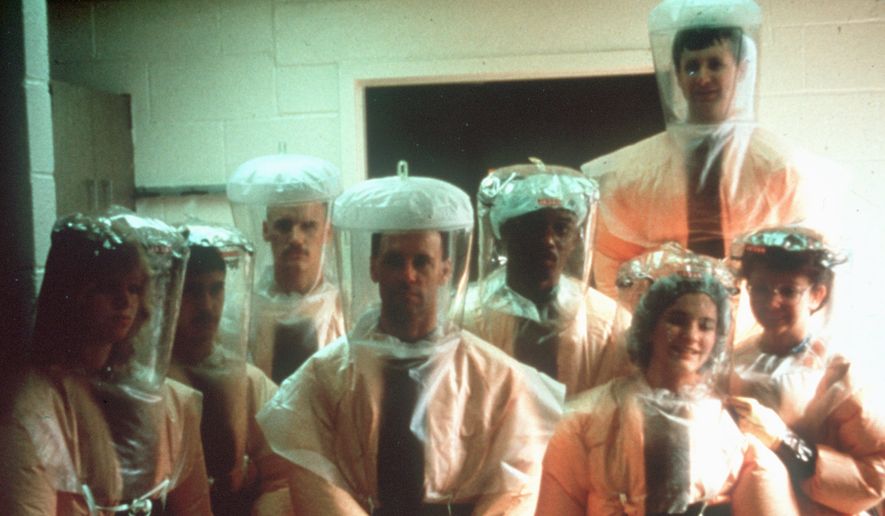Both President Obama and his top infectious disease experts tried to calm Americans’ fears about Ebola this week by saying the current outbreak cannot be transmitted through the air. But less than 30 miles from where top government officials made their declarations in Washington, scientists a quarter century ago did in fact prove that an Ebola strain contained to monkeys could spread airborne.
The 1989 episode at the suburban Reston, Virginia, monkey research facility — made famous by Hollywood movie “Hot Zone” — along with additional research by a scientist who helped fight the Reston outbreak and then went to Africa to treat a later Ebola outbreak in humans — leaves some of the nation’s top disease experts willing to consider that the Ebola virus could mutate or go airborne.
“We can never say never, but I just don’t think the risk is very high,” said Thomas Geisbert, a professor at the University of Texas at Galveston who co-discovered the Reston strain of Ebola.
There’s no evidence of airborne transmission in today’s cases, although a team supervisor for the Reston outbreak, Dr. C.J. Peters, challenged declarations by federal scientists designed to reassure the public at a fearful time.
Dr. Peters wrote in an extensive study on Ebola in humans that he found some evidence that a 1995 outbreak in Congo may in fact have spread in some cases by aerosol transmission.
“We just don’t have the data to exclude it,” Dr. Peters, also a professor at the University of Texas in Galveston, told The Los Angeles Times.
SEE ALSO: Obama open to Ebola czar, but rebuffs travel ban as ‘not the way to go’
Officials say they understand how the virus is spread — direct contact with an infected person’s bodily fluids — and that talk of airborne transmission is unwarranted. To be sure, nothing would be more likely to set off panic among the public.
Dr. Tom Frieden, director of the Centers for Disease Control and Prevention, stressed that point several times before Congress on Thursday.
“We don’t believe it is spreading in any other way,” he told the House Energy and Commerce Committee. “We are confident this is not airborne transmission.”
Even so, Chairman of the Joint Chiefs of Staff Gen. Martin E. Dempsey raised the specter of an airborne mutation in a recent interview with CNN.
“I mean if you bring two, you know, two doctors who happen to have that specialty into a room, one will say, ’No, there’s no way it will ever become airborne,’ but it could mutate, so it would be harder to discover,” he said.
The Ebola virus has killed more than 4,000 in West Africa, mainly in Liberia, Sierra Leone and Guinea. But when the virus came to Texas, Duncan had the benefit of an American intensive care unit.
SEE ALSO: Obama’s Ebola response worries public, Democrats facing midterm elections
The virus is behaving as it usually does and, to be certain, every patient but Duncan has survived their Ebola treatment in the U.S. But use of intravenous lines, mechanical ventilation and dialysis comes with its own risks, experts say.
Jerry and Nancy Jaax, who were among the team of researchers that fought the Reston outbreak and later concluded from lab testing the strain could be transmitted between monkeys through the air, said they’re most concerned about the “droplet hazard,” such as when someone next to you sneezes and you feel a droplet. They also noted the inherent dangers of working in a health care setting.
“Any procedure where you’re invasive, where you’re ventilating, creating an aerosol, or where there’s blood or secretion contamination, you create a risk,” said Mrs. Jaax, who is now retired.
Mr. Jaax said of the current Ebola outbreaks among humans that “nothing’s impossible, but it’s unlikely” that it is being transmitted through the air.
After Reston, lab research showed that the strain could be transmitted by aerosol with special equipment, and monkeys could be exposed through the nose or in situations where the eyes and mucous membranes came in contact with the virus.
“This is effectively a minuscule ’droplet’ type exposure,” the couple said. “There is no evidence Ebola can ’hang in the air for long periods’ — the droplets are heavier than air.”
Rep. Michael C. Burgess, a Texas Republican and doctor, echoed those sentiments, saying thin evidence of airborne transmission does not worry him just yet.
“What keeps me up at night is the fact that you’ve got people involved in direct patient care with patients with enormous viral loads, and that direct contamination is enough to worry about for right now,” Mr. Burgess said.
Some experts say nearly all of the country’s prevention efforts should be focused on hospitals, where administrators often ask infectious disease experts to donate their time or work for little pay when a situation arises.
“If, as a country, we value patient safety and infection prevention in hospitals, we have to rethink that model,” said Eli Perencevich, a professor of internal medicine at the University of Iowa’s Carver College of Medicine.
For their part, the Jaaxes understand what Dallas health care workers are dealing with, as nurses and officials report that Texas Health Presbyterian Hospital did not have top experts and protective gear at its disposal.
“You shouldn’t be working in a fearful condition,” Nancy Jaax said.
Unlike today, Ebola was a foreign concept to much of the American public when they scrambled into action in 1989.
“We were able to sort of do our thing,” said Jerry Jaax, who at the time served as an Army veterinarian at Fort Detrick, Maryland. “From afar, in watching what’s going on here, it would be hard if every decision you made or strategy you developed was an international media circus.”
Hindsight is 20/20, he said, and “nothing is for sure in biology.”
• Tom Howell Jr. can be reached at thowell@washingtontimes.com.




Please read our comment policy before commenting.